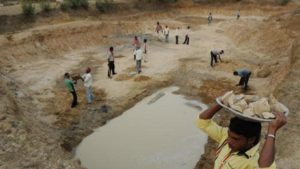MNREGA CAN ADDRESS WATER WOES
Relevance: G.S paper II: Governance & G.S paper III: Conservation, environmental pollution and degradation, environmental impact assessment

Context:
The Mahatma Gandhi National Rural Employment Guarantee Act (MGNREGA) has a strong water management component and they account for almost 40 per cent of funds spent on physical works. This includes creating water storage structures and irrigation sources, implementing watershed works, desilting village tanks, ponds and irrigation canals, carrying out land levelling and afforestation.
Rationale behind
- The rationale behind such a deliberate push to water-related interventions, planned and executed at the level of Gram Panchayats, is to improve the water security in rural areas. Yet even after 15 years, the actual outcome remains unsatisfactory.
- The Centre has spent Rs 3,83,320 crore in the past seven years (2014-2020) alone (is this number only for water structures or the entire). Many of the structures, though, lie defunct.
- A majority of them are poorly constructed due to the absence of sound technical specifications for planning and design of the schemes, and proper expert supervision of the works.
One major shortcoming is the inadequate attention being paid to topography, hydrology and geohydrology and climate of the localities where such interventions are planned.
- So, recharge structures are being built without due consideration to the storage properties of the underlying formations, with the structures functioning as evaporation ponds.
- The unavailability of data at the local level — like the catchment drainage characteristics, volume of runoff that can be harnessed without causing adverse effects downstream; the storage/ yield characteristics of the aquifers — adds to the challenge.
Even when such data are available, there is hardly any technical expertise with the implementing agencies.
The result is oversized schemes, silting and over-crowing of catchments with structures, leading to poor overall efficacy and limited hydrological and economic benefits.
For example, too many ponds have been created in the catchment of hot and arid regions with extremely limited runoff, leading to drying up of streams and traditional water bodies.
The country can be divided into three broad typologies based on agro-climatic, hydrological and geological factors, which can help in determining the appropriate interventions under the scheme.
- Naturally and physically water-abundant region found in the Gangetic plains region of Bihar, Uttar Pradesh and West Bengal; eastern plateau region and east coast plains region of Orissa. Flood control and protection works will be highly effective in such regions with high to moderate rainfall. Focus should also be given to afforestation to stop soil erosion and silting up of reservoirs. Forest cover improves the hydrological regime, by reducing the peak runoff rates, and increasing the evaporation from the shallow groundwater, thereby increasing flood cushioning.
- Naturally water-abundant but physically water scarce region found in the western and eastern Himalayan region; west coast plains and hills region of Maharashtra, Karnataka and Kerala.
Works related to runoff water harvesting and provision of irrigation facilities for economically weak classes are best suited for such regions. They are also perfect for surface water harvesting or creating impoundments. Soil and water management interventions including contour-bunding, drainage control and gully plugging are equally effective in these regions. Small on-farm storages can also be constructed in these hilly areas to provide irrigation facilities on the farmers’ agricultural field. - Naturally and physically water-scarce region, found in Punjab, Haryana and Rajasthan; central, western and southern Plateau region; Gujarat plains and western dry regions. Renovation of traditional water bodies and on-farm water management can be an important intervention in such areas that experience physical water scarcity, owing to water demands far exceeding the total renewable water resources in the region. They also have highly variable monsoon rainfall and high evaporation rates. So management of agricultural water demand is extremely important for mitigating water scarcity in these regions. Keeping this in mind, investments should be on land-leveling for on-farm water management, de-silting & lining of canals, and renovation of traditional water bodies.
This means the employment guarantee scheme can create sustainable assets through careful regional planning and efficient implementation of water management works. It is imperative that when public funds are spent on creating assets in a decentralized manner in villages, a small fraction is spent on providing proper scientific and technical inputs for planning and execution.

